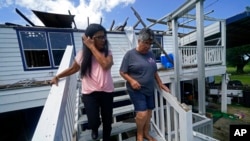The Federal Emergency Management Agency has developed a new strategy to build better relationships with the hundreds of Native American tribes facing climate change-related disasters, the agency said. announced Thursday.
FEMA will include the 574 federally recognized tribal states in its discussion of potential future hazards from climate change. He allocated a $50 million grant to tribes looking for ways to reduce the burden associated with extreme weather. Tribal governments will be provided more training on how to navigate FEMA funding applications. The new plan calls for tribal liaisons to submit an annual report on tribal readiness to her FEMA leader.
"We are seeing communities across the country facing increasing threats as a result of climate change," FEMA Administrator Deanne Criswell said in a conference call with the media. said. "What we want to do with this strategy is reach out to tribal states and help them understand what potential future threats might be."
In recent years, tribal and indigenous Tribal communities are facing upheaval in coping with changing sea levels and increased flooding and wildfires. Tribal citizens live in homes that have either lost their homes or need to be relocated due to coastal erosion. Some people are unable to maintain cultural traditions such as hunting and fishing due to climate-related droughts.
Linda Zambrano, executive director of the National Tribal Emergency Management Council, based in Snohomish, Washington, said historically tribes had to get away with no one to guide them. . For example, her over 200 Indigenous villages in Alaska had to share one her FEMA Tribal Liaison. Or different tribes were told different things. So nonprofits like the council have tried to fill the gap with their own training, she said.
"The way I equate it with the people is that they built the highway, but they never built the ramp," Zambrano said. “If FEMA is starting to build ramps, that would be good.
The tribes have historically been disproportionately affected by natural disasters because they are located in high-risk areas and have little infrastructure, she added.

The ability for federally recognized tribes to directly request emergency and disaster declarations was granted in 2013 under the Sandy Recovery and Improvement Act. It's been a long time since I've been in the middle of a long time. Previously, you had to apply for disaster funds through your state.
The new strategy emphasizes making sure the tribe is informed of all her FEMA grant programs and how to apply for them. It is hoped that this will give them a fair chance to raise funds. FEMA would like to find a way around barriers such as FEMA's share of the cost and some of the federally covered disaster and project funding. In some cases, tribes just can't afford to pay their share.
"What we want to do is work with the tribes to find other sources of funding and bridge the various funding streams that may emerge in areas where we can't. Criswell said
But FEMA's new strategy to engage with Indigenous Peoples appears to be aimed specifically at those with federal approval. It seems to exclude tribes that only have or do not recognize national recognition.In places like Louisiana, many of the Native Americans most affected by climate change are excluded.
When Hurricane Ida makes landfall in 2021, large areas of southeastern Louisiana that have been inhabited by Native Americans for centuries will be devastated. With climate change, hurricanes are expected to get stronger and rain more, but Ida's most affected tribes are preparing for storms and recovering from them because they don't have federal recognition.
Cherie Matherne is the Heritage and Resilience Coordinator for the Pointe-au-Chien Indian Tribe.When she heard about the FEMA announcement, she said: She said she hoped the changes would also apply to non-federally recognized tribes like her.
"It would be an oversight not to work with a nationally recognized tribe." said Mazan, who lives in a trailer next to a demolished house in southeastern Louisiana. “If there were tribal states or subsidies for tribal people, it would be very useful information for people to know.”
FEMA officials said they will continue to work with state and local governments to ensure that
Another change for her under the new strategy is for FEMA staff to meet tribes on their land. This is a request the authorities got from multiple tribes. This includes everything from direct technical assistance in small rural communities to appearances at large national or regional tribal events.
The focus on regular interactions on tribal lands is a major development, said Bill Aubert, co-founder of Northern Arizona University's Institute of Tribal Environmental Professionals. More intimate discussions such as workshops, roundtables and webinars are "very important to the tribe."
"Sending a notification and saying 'I look forward to hearing from you' is one way he does it," he said. “Some of these tribes are small but have very serious needs. FEMA can certainly appreciate that.”
More tribes In addition to providing funding, FEMA can also help tribes by providing them with technical support and other means to prepare for and adapt to climate change, Auberle said.
Efforts to ensure that every tribe has a full understanding of how to access her FEMA assistance and other related grants will be facilitated through webinars, tribal consultations, or FEMA regional staff through regular meetings with
Agency personnel are similarly trained to receive a historical and legal overview of tribal sovereignty and cultural sensitivities.
Zambrano of the National Tribal Emergency Management Council hopes this will lead to all Tribal States getting funding for emergency management programs.
"Our Tribal State is 30 years behind Curveball in developing an emergency management program," she said. "Indian She said no one is better at identifying, mitigating, preparing for and responding to disasters in the Country than the people who live there."


